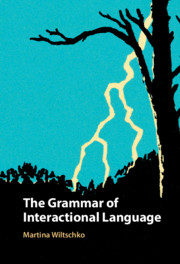
-
Select format
-
- Publisher:
- Cambridge University Press
- Publication date:
- May 2021
- June 2021
- ISBN:
- 9781108693707
- 9781108481823
- 9781108741446
- Dimensions:
- (228 x 152 mm)
- Weight & Pages:
- 0.566kg, 286 Pages
- Dimensions:
- (229 x 152 mm)
- Weight & Pages:
- 0.42kg, 284 Pages
You may already have access via personal or institutional login
Book description
Traditional grammar and current theoretical approaches towards modelling grammatical knowledge ignore language in interaction: that is, words such as huh, eh, yup or yessssss. This groundbreaking book addresses this gap by providing the first in-depth overview of approaches towards interactional language across different frameworks and linguistic sub-disciplines. Based on the insights that emerge, a formal framework is developed to discover and compare language in interaction across different languages: the interactional spine hypothesis. Two case-studies are presented: confirmationals (such as eh and huh) and response markers (such as yes and no), both of which show evidence for systematic grammatical knowledge. Assuming that language in interaction is regulated by grammatical knowledge sheds new light on old questions concerning the relation between language and thought and the relation between language and communication. It is essential reading for anyone interested in the relation between language, cognition and social interaction.
Contents
Metrics
Altmetric attention score
Full text views
Full text views help Loading metrics...
Loading metrics...
* Views captured on Cambridge Core between #date#. This data will be updated every 24 hours.
Usage data cannot currently be displayed.
Accessibility standard: Unknown
Why this information is here
This section outlines the accessibility features of this content - including support for screen readers, full keyboard navigation and high-contrast display options. This may not be relevant for you.
Accessibility Information
Accessibility compliance for the PDF of this book is currently unknown and may be updated in the future.


